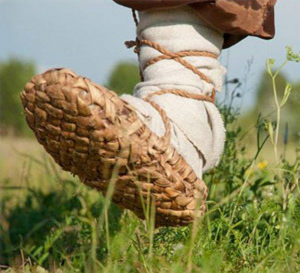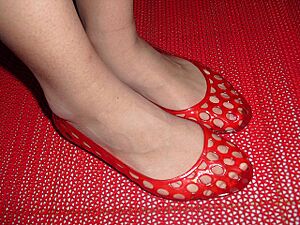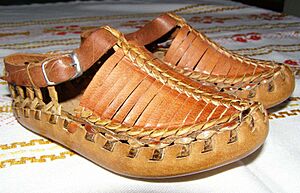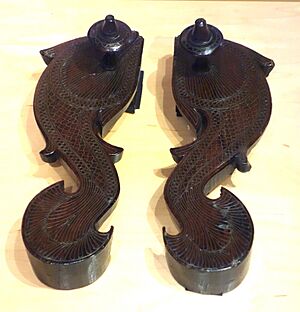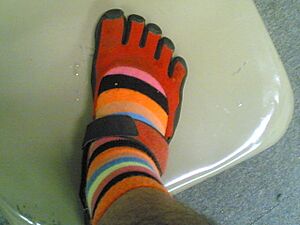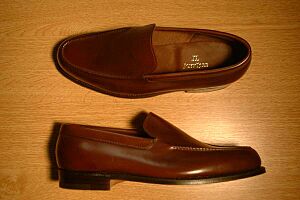List of shoe styles facts for kids
Shoes are amazing inventions that protect our feet and help us do all sorts of activities, from running and jumping to dancing and exploring! They also let us show off our personal style. Imagine trying to play soccer or hike a mountain without the right shoes – it would be tough!
Throughout history and in different cultures, shoes have looked very different. Their design often depended on what they were used for. For example, a shoe for walking in snow would be very different from a shoe for dancing. Fashion trends have also played a big role, deciding if shoes have super high heels or are completely flat. Today, you can find shoes in countless styles, from simple sandals to complex athletic shoes, and they can vary a lot in how they look and how much they cost.
Making shoes, called shoemaking, used to be a craft where each shoe was carefully made by hand. Skilled artisans would cut and shape leather, then stitch it together to create a shoe that fit perfectly. This traditional way of making shoes focused on high quality and unique details. Today, most shoes are made in large factories using special machines. This allows millions of pairs of shoes to be produced much faster and at a lower cost. However, even with modern technology, the basic idea of designing and assembling different parts to create a comfortable and protective shoe remains the same.
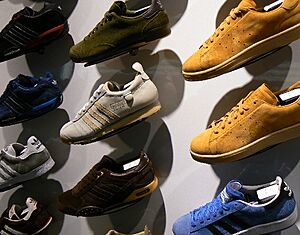
Contents
Exploring Different Shoe Styles
There are so many kinds of shoes in the world, each designed for a special purpose or to look a certain way! Let's explore some of the most popular and interesting shoe styles you might see or wear.
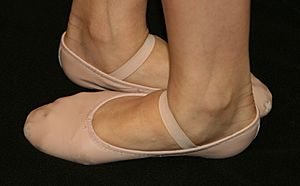


Boots for Every Adventure
Boots are strong shoes that cover your foot and ankle, and sometimes even more of your leg! They are great for protection and can be very stylish.
- Australian work boots: Tough boots for hard work.
- Beatle boots: Stylish boots with pointed toes and Cuban heels, made famous by The Beatles.
- Bovver boots: Sturdy, often heavy boots.
- Caulk boots: Boots with spikes on the sole for grip, often used by loggers.
- Cavalier boots: Tall, fancy boots worn by horse riders in the past.
- Chap boots: Boots that are part of a larger leg covering.
- Chelsea boots: Snug-fitting ankle boots with elastic sides, easy to pull on.
- Chukka boots: Ankle-high boots, usually with two or three eyelets for laces.
- Desert boots: A type of chukka boot, often made of suede, popular for casual wear.
- Combat boots: Strong, durable boots designed for soldiers.
- Desert combat boots: Lighter combat boots for hot, sandy places.
- Jungle boots: Combat boots designed for wet, tropical environments.
- Cowboy boots: Iconic boots with a high shaft and angled heel, perfect for riding horses.
- Dress boots: Formal boots for special occasions.
- Engineer boots: Heavy-duty boots, often worn by motorcyclists.
- Fashion boots: Boots designed mainly for style and trends.
- Galoshes: Waterproof overshoes worn to protect regular shoes from rain.
- Go-go boots: Stylish, often white, boots popular in the 1960s.
- Gutals: Traditional Korean boots.
- Hessian boots: Tall boots with a V-cut front, popular in the 18th and 19th centuries.
- Hiking boots: Sturdy boots designed for walking on trails and rough terrain.
- Hip boots: Very tall, waterproof boots that reach up to the hip, used for fishing or working in water.
- Hwa: Traditional Korean shoes, often with embroidery.
- Jackboots: Strong military boots, often reaching the knee.
- Jodhpur boots: Ankle-high riding boots.
- Jump boots: Boots worn by paratroopers.
- Knee-high boots: Boots that reach up to the knee.
- Motorcycle boots: Protective boots for riding motorcycles.
- Mountaineering boots: Very strong, insulated boots for climbing mountains.
- Rigger boots: Pull-on safety boots, often used in industrial settings.
- Safari boots: Lightweight, durable boots for outdoor adventures.
- Sailing boots: Waterproof boots for boating.
- Sheepskin boots: Warm boots lined with sheep's wool, like Uggs.
- Thigh-high boots: Boots that reach up the thigh.
- Tzangion: Ancient Byzantine military boots.
- Ugg boots: A popular brand of sheepskin boots.
- Wellington boots: Waterproof rubber boots, also known as "wellies," great for rainy weather.
Everyday Comfort and Casual Shoes
These shoes are perfect for daily wear, offering comfort and style for school, hanging out with friends, or just relaxing.
- Abaca slippers: Slippers made from abaca fiber.
- Abarka: Traditional Basque leather sandals.
- Avarca: Simple leather sandals from Menorca, Spain.
- Bakya: Traditional wooden clogs from the Philippines.
- Balgha: Soft leather slippers from North Africa.
- Ballet flats: Soft, flat shoes inspired by ballet shoes, popular for everyday wear.
- Bast shoes: Traditional shoes made from tree bark, common in Eastern Europe.
- Blucher shoes: A type of shoe similar to a Derby, with open lacing.
- Boat shoes: Casual shoes with non-slip soles, originally for sailing.
- Brogan: A sturdy, heavy work shoe.
- Brogue: Shoes with decorative perforations (small holes) on the leather.
- Buskin: A high-laced boot worn in ancient times, especially by actors.
- Caligae: Strong, open-toed sandals worn by Roman soldiers.
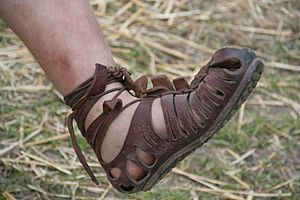 A reproduction of caligae, Roman soldier sandals.
A reproduction of caligae, Roman soldier sandals. - Calceus: A closed Roman shoe.
- Cantabrian albarcas: Rustic wooden shoes from northern Spain.
- Clogs: Shoes with thick, often wooden, soles.
- British clogs: Traditional clogs from Britain.
- Turkish clogs: Clogs from Turkey.
- Crocs: Lightweight, comfortable, and waterproof foam clogs.
- Diabetic shoes: Special shoes designed for people with diabetes to protect their feet.
- Driving moccasins: Soft, flexible shoes designed for comfort while driving.
- Earth shoes: Shoes designed with a negative heel (heel lower than the toe) for a natural walking posture.
- Espadrille: Light, casual shoes with a rope sole, often made of canvas.
- Furlane: Traditional velvet slippers from Venice, Italy.
- Galesh: Traditional Iranian rubber boots.
- Giveh: Traditional Iranian hand-woven shoes.
- Gomusin: Traditional Korean rubber shoes.
- Haferlschuh: Traditional Bavarian shoes, often with side lacing.
- Huarache: Traditional Mexican woven leather sandals.
- Jelly shoes: Shoes made of PVC plastic, often colorful and transparent.
- Jika-tabi: Japanese split-toe shoes, often worn by construction workers.
- Jipsin: Traditional Korean straw shoes.
- Jutti: Traditional Indian leather shoes, often embroidered.
- Klomp: Dutch wooden clogs.
- Kolhapuri Chappal: Hand-crafted leather sandals from India.
- Kung fu shoes: Simple, lightweight canvas shoes used in martial arts.
- Light-up shoes: Shoes with lights that flash when you walk.
- Loafer: See Slip-on.
- Mary Jane: Classic shoes with a strap over the instep, often worn by children.
- Moccasin: Soft, comfortable shoes made from a single piece of leather wrapped around the foot.
 A soft-soled moccasin, a very comfortable shoe.
A soft-soled moccasin, a very comfortable shoe. - Monk shoe: Dress shoes with buckles instead of laces.
- Mukluk: Soft, warm boots traditionally worn by Arctic indigenous peoples.
- Mule: Shoes that are backless and often closed-toe.
- Multani Khussa: Traditional Pakistani embroidered leather shoes.
- Namaksin: Traditional Korean wooden shoes.
- Okobo: Tall wooden clogs worn by Japanese geisha apprentices.
- Opanak: Traditional peasant shoes from the Balkans, often with a distinctive toe.
- Opinga: Another type of traditional Balkan shoe.
- Orthopaedic footwear: Shoes designed to support and correct foot problems.
- Oxford shoe: Formal lace-up shoes with closed lacing.
- Wholecut: An Oxford shoe made from a single piece of leather.
- Paduka: Ancient Indian toe-knob sandals.
- Pampootie: Traditional Irish raw-hide shoes.
- Patten: Wooden overshoes worn in medieval times to raise feet above mud.
- Peep-toe shoe: Shoes with a small opening at the toe.
- Penny loafer: A type of slip-on loafer with a strap across the vamp, often with a slot for a penny.
- Peranakan beaded slippers: Beautifully embroidered and beaded slippers from Southeast Asia.
- Peshawari chappal: Traditional Pakistani leather sandals.
- Platform shoe: Shoes with a very thick sole, making the wearer taller.
- Plimsoll shoe: Simple canvas shoes with rubber soles, often used for sports or casual wear.
- Pointinini: A type of pointed shoe.
- Poulaine: Shoes with very long, pointed toes, popular in medieval Europe.
- Pulhoer: Traditional Korean straw shoes.
- Rocker bottom shoe: Shoes with a rounded sole that helps with walking motion.
- Roller shoes: Shoes with wheels in the heel, like Heelys.
- Heelys: A popular brand of roller shoes.
- Rope-soled shoe: Shoes with soles made from braided rope.
- Russian boot: A type of tall boot.
- Sabot: A type of wooden clog.
- Saddle shoe: Casual shoes with a contrasting color panel in the middle, resembling a saddle.
- Sandal: Open shoes with straps that hold the sole to your foot.
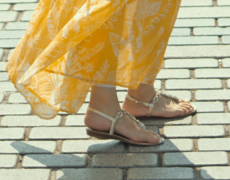 Stylish Sandals with straps and a thong.
Stylish Sandals with straps and a thong.- Biblical sandals: Simple leather sandals, like those worn in ancient times.
- Coiled sewn sandals: Sandals made with coiled and sewn materials.
- Flip-flops: Simple sandals with a Y-shaped strap between the toes.
- Geta: Traditional Japanese wooden sandals with raised platforms.
- Hnyat-phanat: Traditional Burmese sandals.
- Ho Chi Minh sandals: Simple sandals made from recycled tires, used during the Vietnam War.
- Saltwater sandals: Durable, waterproof leather sandals.
- Zori: Traditional Japanese flat sandals.
- Self-tying shoes: Shoes that can automatically tighten their laces.
- Slide: Open-toed sandals with a single wide strap across the foot.
- Slingback: Shoes with a strap that goes around the back of the heel.
- Slip-on shoes: Shoes without laces or buckles that you can easily slide your foot into, also called loafers.
Comfortable blue branded slip-on shoes.
- Slipper: Soft, comfortable shoes for wearing indoors.
- Snow boots: Warm, waterproof boots designed for walking in snow.
- Soccus: A type of Roman slipper or low shoe.
- Spectator shoe: Stylish shoes with two contrasting colors, often with brogue details.
- Steel-toe boot: Safety boots with a protective steel cap in the toe.
- T-bar sandal: Sandals with a T-shaped strap over the instep.
- Tiger-head shoes: Traditional Chinese children's shoes decorated with a tiger face.
- Träskor: Swedish wooden clogs.
- Toe shoes: Shoes designed to fit each toe separately, like a glove for your foot.
- Tsarouchi: Traditional Greek leather shoes with a distinctive pompom.
- Turnshoe: A method of shoemaking where the shoe is made inside out and then turned right side out.
- Upanah: Ancient Indian sandals.
- Uwabaki: Japanese indoor slippers, often worn in schools.
- Valenki: Traditional Russian felt boots, very warm.
- Veldskoen: South African desert boots, similar to chukkas.
- Venetian-style shoe: Elegant slip-on shoes, often loafers.
- Waders: Waterproof boots or clothing that cover the legs and sometimes the torso, used for fishing.
- Walk-Over shoes: A brand of classic American shoes.
- Waraji: Traditional Japanese straw sandals.
- Water shoes: Shoes designed to be worn in and around water, offering grip and protection.
- Wedge: Shoes with a sole that forms a solid wedge from the heel to the toe.
- Winklepicker: Shoes with a very sharp, pointed toe, popular in the 1950s and 60s.
- Wörishofer: A brand of comfortable, orthopedic-style shoes.
- Xiuhuaxie: Traditional Chinese embroidered shoes.
Sporty and Performance Shoes
These shoes are built for specific activities, helping athletes and active people perform their best.
- Ballet boot: A type of boot that looks like a ballet shoe but is a boot.
- Ballet shoe: Soft, flexible shoes worn by ballet dancers.
- Pointe shoe: Special ballet shoes with a hardened toe box, allowing dancers to stand on their toes.
- Cleats: Shoes with studs or spikes on the sole for grip on soft ground, like football boots.
- Climbing shoes: Tight-fitting, sticky-soled shoes for rock climbing.
- Cross country running shoes: Lightweight shoes designed for running on varied terrain.
- Cycling shoes: Stiff-soled shoes that attach to bicycle pedals.
- Flamenco shoes: Shoes with special heels and toes for rhythmic tapping in flamenco dance.
- Ghillies: Soft, laceless shoes worn for Irish and Scottish dancing.
- High-top: Sneakers or boots that extend up over the ankle.
- Hiking shoes: Lighter versions of hiking boots, good for less rugged trails.
- Jazz shoes: Flexible, soft shoes for jazz dance.
- Organ shoes: Special soft-soled shoes worn by organists to play pedals.
- Racing flat: Very lightweight running shoes designed for speed.
- Racing shoes: General term for shoes designed for competitive sports.
- Riding boots: Boots specifically designed for horse riding.
- Ski boots: Stiff, strong boots that connect to skis.
- Skate shoes: Durable shoes designed for skateboarding.
- Sneakers: Athletic shoes, also known as trainers or tennis shoes, used for sports or casual wear.
- Trail running shoes: Sneakers specifically designed for running on trails.
- Tap shoes: Shoes with metal plates on the toe and heel for making rhythmic sounds.
- Wrestling shoes: Lightweight, flexible shoes that provide grip and ankle support for wrestling.
Fancy and Formal Footwear
These shoes are often worn for special events, parties, or when you want to look extra sharp!
- Chopine: Very tall platform shoes popular in 15th-17th century Europe.
- Ciocia: Traditional Italian shoes.
- Court shoe (British English), pump (American English), or d'Orsay pumps: Elegant, often high-heeled, shoes.
- Dress shoe: Formal shoes worn with suits or other dressy outfits.
- Duckbill shoes: Shoes with a wide, blunt toe, popular in the 16th century.
- Elevator shoes: Shoes with hidden lifts inside to make the wearer appear taller.
- Episcopal sandals: Special sandals worn by bishops in some Christian churches.
- Hanfu footwear: Traditional shoes worn with Chinese Hanfu clothing.
- High-heeled footwear: Shoes with a raised heel.
- Clear heels: High heels made of transparent material.
- Stiletto heel: A very thin, high heel.
- Kitten heel: A short, slender heel.
- Lotus shoes: Small, decorative shoes from historical China, known for their unique shape.
- Mexican pointy boots: Boots with extremely long, pointed toes, popular in some parts of Mexico.
- Mojari: Traditional Indian leather shoes, often with intricate embroidery.
- Over-the-knee boot: Boots that extend above the knee.
- Pigache: Medieval shoes with a pointed toe.
- Spool heel: A heel that is wider at the top and bottom, and narrower in the middle, resembling a spool of thread.


